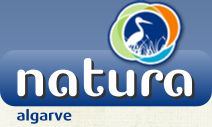Birdwatching Algarve
02.02.2009 // Natura Algarve The Algarve is a region with exceptional natural conditions and many parts of the countryside, namely nature reserves and protected landscape areas, have exactly the sort of characteristics that are sought after by one very special kind of tourist - the bird watcher.
The Algarve is a region with exceptional natural conditions and many parts of the countryside, namely nature reserves and protected landscape areas, have exactly the sort of characteristics that are sought after by one very special kind of tourist - the bird watcher.
All year round, in the case of the birds that live permanently in the area, and particularly in October, in the migratory season, the Algarve is home to a whole host of species that attract the attention of nature lovers. At this time of year, the areas around Sagres and Cape St. Vincent are the places sought out preferentially by the migratory birds, and most of the species that make their way to Africa each winter pass through here, particularly the great glider birds that circle for hours on the thermal air currents.
October is, therefore, a good time for discovering a little more about the life and behaviour of these birds. There are many places on the cliffs and crags of the municipality of Vila do Bispo or Aljezur, where the birds’ migratory flights can be observed, which is why scores of ornithologists come here every year, including both Portuguese and foreign professional bird watchers.
To take advantage of this phenomenon occurring each autumn, the World Bird Watchers’ Festival is held here every year, offering visitors the chance to take part in walks organised by specialists, whose explanations make the experience of bird watching even more exciting. The Algarve section of the League for the Protection of Nature and Almargem, an association formed for the protection of the Algarve’s cultural and environmental heritage, both dedicate their October nature walks to the study of birds.
The Costa Vicentina Natural Park is the only place in the world where white storks are known to build their nests on sea cliffs. These same cliffs are similarly chosen for nesting purposes by great white herons and Bonelli’s eagles. The south-west coast is also one of the last refuges for the osprey in the Mediterranean region. You can also find the chough and the rock dove here.
Some of the birds in this Natural Park are in imminent danger of extinction. This is the case, for example, with the osprey, so that great care must be taken to interfere as little as possible with its habitat. Respecting the code of silence and keeping to the marked paths are two ways of showing the appropriate care, and this behaviour will generally be rewarded with the chance to observe many examples of the more than 200 bird species that nest here. Binoculars are essential and, in some cases, it may be useful to use a telescope. Suitable clothes should be worn, with colours that are similar to those found around the observation posts. Footwear should also be suitable for walking on this sort of terrain, including the wearing of waterproof boots when visiting wetland habitats. A guide for identifying the different types of birds and a notebook are also considered to be essential items in the birdwatcher’s equipment.







